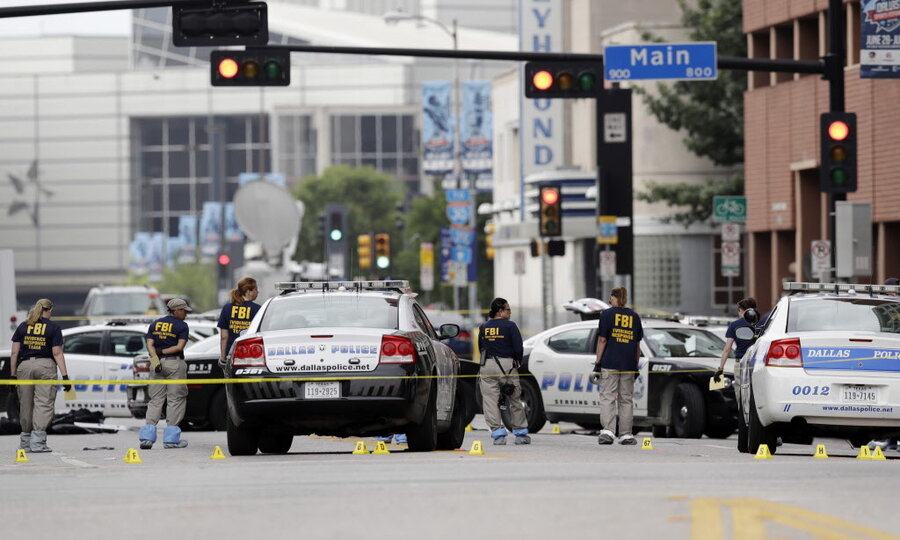What does Dallas's 'bomb robot' mean for the future of policing?
Loading...
Havoc broke out at a peaceful protest against police violence and racism in Dallas on Thursday evening when a sniper opened fire, shooting 12 officers and 2 civilians.
Police cornered the suspect, now known to be Micah Johnson, in a downtown parking garage around 11 p.m. As negotiators tried to talk him out of the parking deck over a series of hours, news came out that five of the officers had died. Negotiations broke down; gunfire was exchanged between police and Mr. Johnson.
Then, around 3 a.m., police reported that the sniper was dead. Later that morning, when city officials held a press conference, the details of Johnson’s death emerged: he was killed by explosives delivered by a remote-controlled robot.
“We saw no other option but to use our bomb robot and place a device on its extension for it to detonate where the suspect was,” said Dallas police chief David Brown.
Experts say this is the first use of a robot to kill a suspect in the history of US law enforcement.
While robotic drones are used for kill missions in several military contexts around the globe, the appearance of a killer robot on American soil has sparked renewed debate about the use of this kind of technology.
“We use the predator drone to target people overseas, and now we see the police force using a [robot] to target someone in a US city, and that catches people's attention,” says Peter Asaro, a professor of media studies at The New School in New York City, who specializes in artificial intelligence and robotics.
Debate about Johnson's death is situated within a larger conversation about police militarization and why it has become a law enforcement trend. That question has been central to the Black Lives Matter movement, which gained momentum in the protests against the death of Michael Brown in Ferguson, Mo., – protests whose optics included police in Kevlar vests, camouflage, and armored vehicles.
Militarized equipment, including this bomb-wielding robot, has become increasingly common in domestic police forces, as a result of the government’s 1033 program that filters excess military equipment into domestic law enforcement departments.
An analysis done last summer by the Center for the Study of the Drone at Bard College used Pentagon Defense Logistic Agency data to map out all the “explosive ordnance disposal” robots that now belong to domestic law enforcement agencies. They found that 201 agencies have at least one.
While the use of military equipment against civilians is highly contentious, robot technology has become a common way for law enforcement to gain control in hostage, bomb, and barricade situations, says Joseph Pollini, a retired NYPD lieutenant commander who was involved in hostage negotiations during his time with the force.
“The robot has been around for a pretty long time now,” says Professor Pollini, who now teaches at John Jay College of Criminal Justice. “If a local jurisdiction doesn’t have one, the county or the state or the federal government does have it.”
Robots have been instrumental in decreasing police risk, he tells the Monitor, for example taking officers out of the immediate line of danger when there's a bomb. “If there’s a way to utilize the robot, they most certainly use the robot first before sending a technician in.”
For Pollini, the use of an explosive was more surprising than the use of a robot. “In my entire career I’ve never heard of using an explosive device to terminate someone,” he says.
The device used in downtown Dallas was a bomb disposal robot that officers rigged with C4, according to Dallas Mayor Mike Rawlings. It was the combination of the robotics technology with the explosive that placed this response in new territory.
“This is a very exceptional case, and so we don’t want to see this as a model,” Professor Asaro of The New School tells The Christian Science Monitor.
“There is a huge concern about the weaponization of robotic platforms, as these technologies become more sophisticated and more autonomous, and weapons are actually quite easy to attach to them,” both by civilians and police, he says.
“It's very likely that the police will continue to adopt drone technology” for a variety of purposes, he says, outlining two particular concerns with these developments.
One is his worry that an industry for weaponized robots could make this technology readily available for use. The other is the increasing automation of militarized robots that may not need a human command to act, which “raises a whole different set of ethical issues.”
The debate about the use of the explosive-strapped robot to kill Johnson has largely centered around whether there were other options, like flash grenades and tranquilizers, and whether the situation rose to the level of imminent danger that legally justifies lethal force.
But viewing the situation with an eye to the future raises a question about what the future of policing – and violence in general – could look like when combined with evolving robotic and drone technology.
“It’s something we have to look at," Asaro says. "Whether it's law that makes restrictions explicit on weaponizing these kinds of systems, or trying to restrict access to the weapons themselves.”






